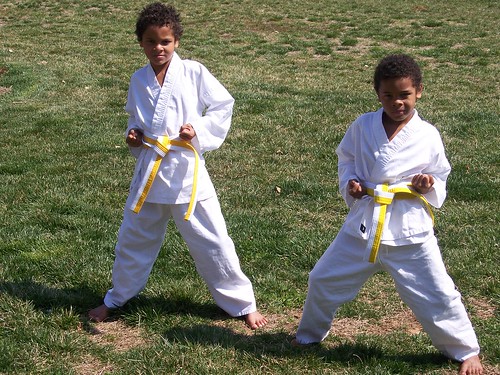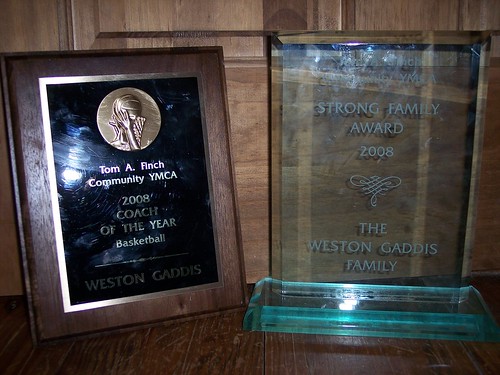
Our beloved Socks, the patriarch cat and oldest Gaddis pet, died last night at the age of 17 years, having lived in feline happiness from August 22, 1992 until December 9, 2009. He was older than 4 of my 7 children, and lived with us longer than 3 of my 7 children. He was our first official pet. He was the only cat we actually bought, from a lady who discovered she was allergic to him. He was 1.5 years old and we brought him home in March, 1992. We were living in our first home in Gibsonia, PA:

I have a couple fond memories of Socks in our first home (from February, 1994-April, 1995). The first was that I had him in Weston and I’s bedroom the first couple weeks as he acclimated to our home with four small children. He had these little fuzzy balls that his previous owner said he really liked. Well, one morning I awoke to something dropping on my hand. When I opened my eyes and looked, it was one of those little fuzzy balls and Socks was staring at me . . . waiting. Puzzled, I picked it up, pondered, then decided to throw it. Off Socks shot, so I closed my eyes. Seconds later, I feel a plop on my hand again, and there sat Socks, staring at me . . . like a dog! What?! It wasn’t long before his more human-like personality emerged. Here is Socks shortly after getting him:

Further, Socks was to be an inside cat. However, Socks did not like this idea whatsoever. He had already endured 1.5 years of his life inside, sitting at the windows craving to be outside, and he took every opportunity to try to trick us when we came in or out of the house to try to escape. In June of 1992, we heard a meow from our front bushes and out came a brown tabby male stray cat. He began to take the next few weeks trying to get into our house, as Socks tried to get out. Weeks later, I decided to give up and invited the stray, Bob, inside and released Socks to be free to come and go outside. That began a beautiful relationship between the older and wiser Bob who would teach Socks how to hunt and be an outdoor cat. Here they are:

Our family has wonderful memories of sitting on our back deck of this first house at around 6:00-7:00 p.m. and watching the “cat games” between the two cats. Apparently, Socks was to try to sneak up behind Bob without him noticing. Whenever Bob would turn and look, Socks would stop stalking and try again later. One time, Socks was mid-flight towards pouncing on Bob when Bob turned to look, and Socks literally somehow did a flip in the middle of the air and landed beyond him as he had “lost” again. The good news is that Socks became a good hunter and began his love of the outdoors.
Our first house was short-lived before it was time for our family to transfer to Kentucky. Naturally, Socks and Bob came with us. Here is our second home we owned:

We lived here from March, 1995 until May, 1998. Since it was our first move with a pet, we wanted to be sure to acclimate our cats to the new home before allowing them outside. However, they were eager to explore their outside environment, so about 2 weeks into it, we let them out. And they disappeared. It was days, and they were not the type to leave our yard, so we became concerned. Now, a week into their disappearance, I began to accept the inevitable. In fact, Weston saw a dead black and white cat up the road, and we feared it was him, though we could not tell. I came home to find Abbey in her bedroom, praying, about the cats. With all faith, she pleaded that Heavenly Father would bring them home. I remember specifically thinking, “Oh, no, now her faith will be tested,” since I was sure they were gone. I tried to talk to her, but Abbey matter-of-factly stated, “Oh, Socks and Bob will be coming home.” As I stayed inside to comtemplate the hardship of it all, I heard her yell to me, “Mom! Socks and Bob are home!” And sure enough, as I ran downstairs, there they were. In the end, it was my faith that was strengthened, from a child’s. Though we lived near a busy road, our cats seemed smart enough to stay away from it and stick to the surrounding fields as their foray places. Here are some pictures of Socks in Kentucky. This is him hiding under Eli’s bed:

And him sitting in Alex’s high chair:
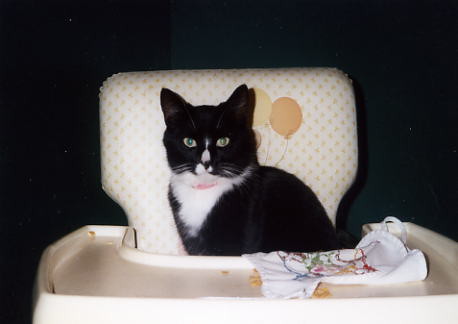
Then it was time to move again . . . to a log house in central PA:

We only lived in this backcountry home for a short six months in the year 1998 (June-December), but it was a time of healing and peace and tranquility . . . for most of us. Socks, however, must have wondered where we dragged him as one evening, with the windows open as this place had no air conditioning with the natural coolness of the wooded lot and high mountaintop we were living upon, when we heard what appeared to be a cat scream . . . a BIG cat scream. Stupid us grabbed a flashlight and went out on the porch and shined where we heard the noise. On one side of a large tree was a cougar, and on the other side of that same tree, with wide-eyes, was Socks! Apparently they bumped into each other, and when we came, the cougar slowly turned around and walked away. Socks, however, zipped into the house.
Circumstances created the opportunity for us to move more “in town” to civilization here at the Lindy house:

We were at this house from December, 1998 until May 2000. Initially, the cats stayed in the basement (we now had Belle and one of her kittens, Sunflash, but Bob had passed away in KY) because we had added a dog, though a few months into this house, we found a new home for him as it wasn’t fitting our lifestyle yet at the time. However, Socks was one never to be kept up, so he dared to come around the house faster than the others, as well as outside. Here he is on Abbey’s bed:

And here he is outside:

From here, it was moving to North Carolina into our Trinity home:
Buy Vigra online with affordable price at www.edpremium.com purchase cialis online https://unica-web.com/DEUTSCH/2015/GA2015-patronage-report.html is an erectile brokenness medication pill to let a male receive in return.

We were in this house the longest we had ever lived anywhere: from June 2000 to December of 2007. Weston began to do English gardening around the home and this is where Socks became our Ferdinand cat, sleeping under the rose bushes many hours of most days. Here are the pictures from that home, all with the theme Outside! Here he is with Sunny:
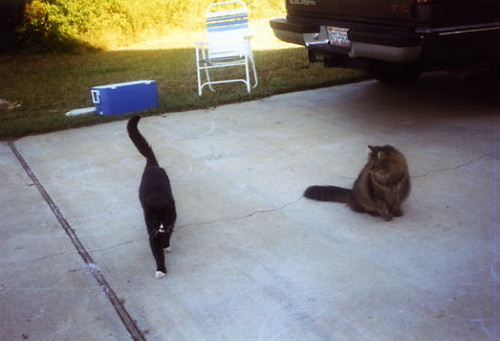
And near the front of the house:
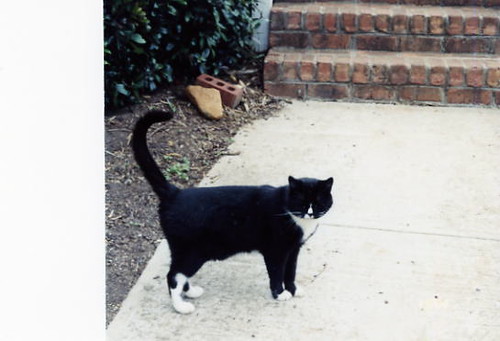

Socks and I, and Socks and Eric had the closest relationship. Socks slept in my bed for years at my feet. Here he is with me on the back deck of this house:

He also starred in a movie made by Abbey for Alex found here:
continued here:
and concluded here (stay tuned after the “The End” for a surprise):
Finally, we ended up at our final (hopefully) home here in our log house in central North Carolina:

I was able to get some pictures of Socks sleeping under the bushes in our new house. He had to wait a bit until Weston transferred some of our roses from the old house to the new one. It was never quite the same as the old house, but it would do. He also got really, really old . . . skinny and clumped fur from not grooming, but he was still so strong in spirit that I just couldn’t put him down.



The star quality of Socks continued as patrairch of the cat home and Abbey wrote a book about him in a series of books about all the cats for Alex for Christmas. Here is his cover:

In highlighting the life of Socks, we also highlighted the travels of the Gaddis family. He has been with us from the first house we purchased, to our last. His spirit carried his body farther than it was meant to go, and we celebrate his strength and love he always shared. Joseph Fielding Smith has said that the spirits of animals will be resurrected. We believe that so strongly, and having shared the love of Socks, it could not be any other way. We will see him again! Until then, may he rest in peace until he can frolick in the gardens of Heaven.



